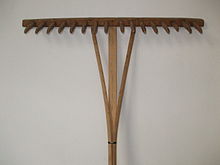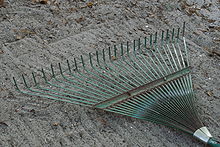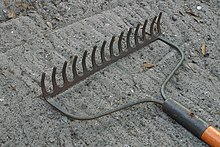Rake (tool)

The rake and the northern rake (partly synonymous) are hand tools with a handle , a stick placed across it, the "spar" or "rake bar", and several short extensions, the "prongs" . Depending on the version, the device is used to pull together loose material ( leaves , grass clippings or hay ), to create furrows for seeds or to work the soil (loosening, cleaning plant residues and stones, levels and spreading). It can also be used to distribute materials such as gravel , concrete or bitumen in road construction. It is used in agriculture , horticulture and the construction industry .
Type and inventory
The head of a rake is usually made of metal or wood. Plastic is used less often because its impact resistance is usually insufficient for use. Sometimes, however, a gentle treatment of the subsoil is desired, in which case the flexible tines of a plastic version are more suitable.
The original form is the hay rake , which was developed for haymaking (and later further transport) as early as Roman times . This rake corresponds physiologically to the splayed fingers , which it expands in their functional scope. In northern German usage, this wooden rake with a longer handle of around 2 m is the actual rake. There are also hay rakes made of light metal.
Heavy rakes with spars and tines made of sturdy steel and comparatively shorter handles are known as earth rakes and are used to level loose earth, sand, gravel and other soft soils. They are the small version of the harrow . For North Germans, it is the real rake .
As spring brush , leaf rake , leaf rake , Sweep or subjects rake designated execution is primarily used for sweeping up of leaves. Its fan-like construction, usually adjustable in width, in conjunction with the particularly long, springy prongs enables the user to work with comparatively little pressure. The narrow tines, which are cranked at the end, do not get stuck because they are pulled across the ground at a fairly flat angle.
use
- For the cultivation of well-kept lawns, narrow-toothed metal rakes are more suitable, as they can also collect small parts and at the same time scarify the lawn .
- In dense, matted and overgrown areas, a wide-toothed wooden rake is more suitable because it does not “ get stuck ” so easily. So this rake still has its right to exist today, even if it is often taken for a museum piece.
- A special form used to be a special ear rake with particularly narrow and curved, thin tines. This metal construction is also known as a (metallic) hay rake .
- The rake is the most important tool for creating a kare-san-sui , a form of the Japanese garden .
- Pond rakes are special rakes for cleaning ponds, which, due to their size, were pulled by horses in the past and are now used as hand tools.
Linguistic
The dividing line between the synonymous generic terms rake and rake runs in the west around the Benrath line , in the east a little south, north of Dresden, slightly to the northeast. In the north, a distinction is made between the two terms in terms of meaning. The rake is the earth rake for smoothing the garden beds and paths, and the rake is the hay rake for raking leaves and grass. The associated verb is in the north rake and south rake (often dialektal in Austria expect ). Even with those northern Germans who differentiate between the work tools, the phrase “raking leaves” is not perceived as wrong.
Occasionally and misleadingly, the designation Forke is used in northern Germany , a device also provided with prongs, which is used, among other things, for tasks similar to the rake. The comb is also jokingly referred to as the lice rake or lice rake. In southern Germany, the term rake is used for a type of hoe with a cross-sided blade for soil cultivation.
Web links
Individual evidence
- ↑ a b c d Jürgen Eichhoff: Word Atlas of German Colloquial Languages , Volume 1, Saur, 1977, ISBN 9783772013379 , page 23
- ↑ dtv Atlas on the German Language (1st edition 1978) p. 237
- ↑ a b c Helmut Protze: Word Atlas of urban colloquial language (Volume 114 of Mitteldeutsche Forschungen ), Böhlau, 1997, ISBN 9783412142964 , p. 63



